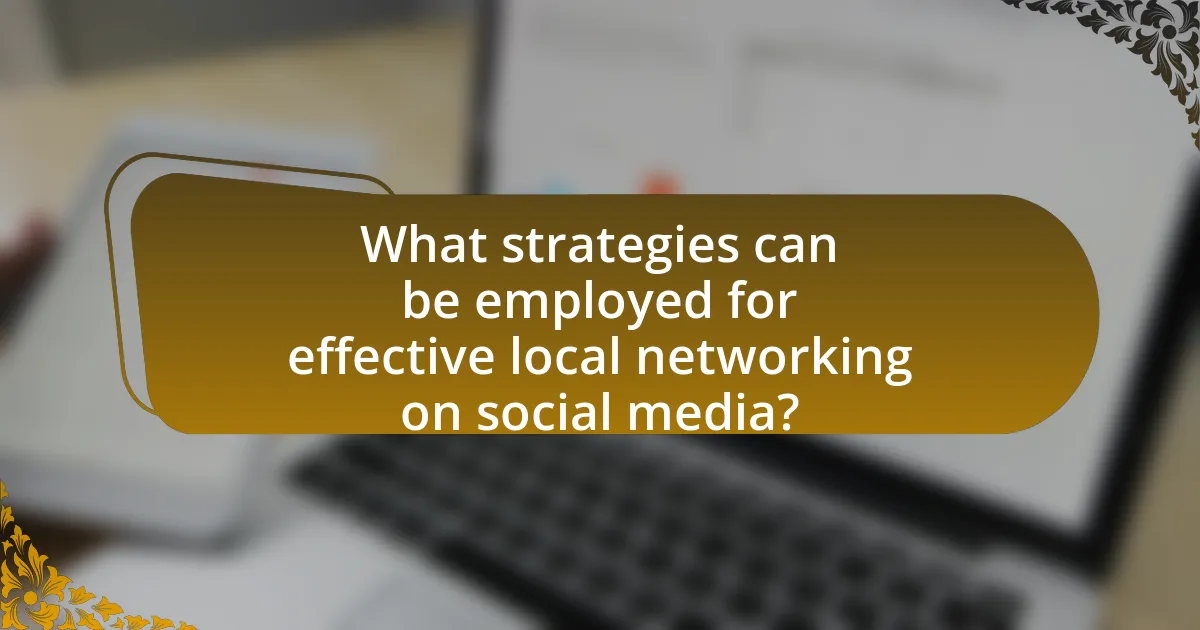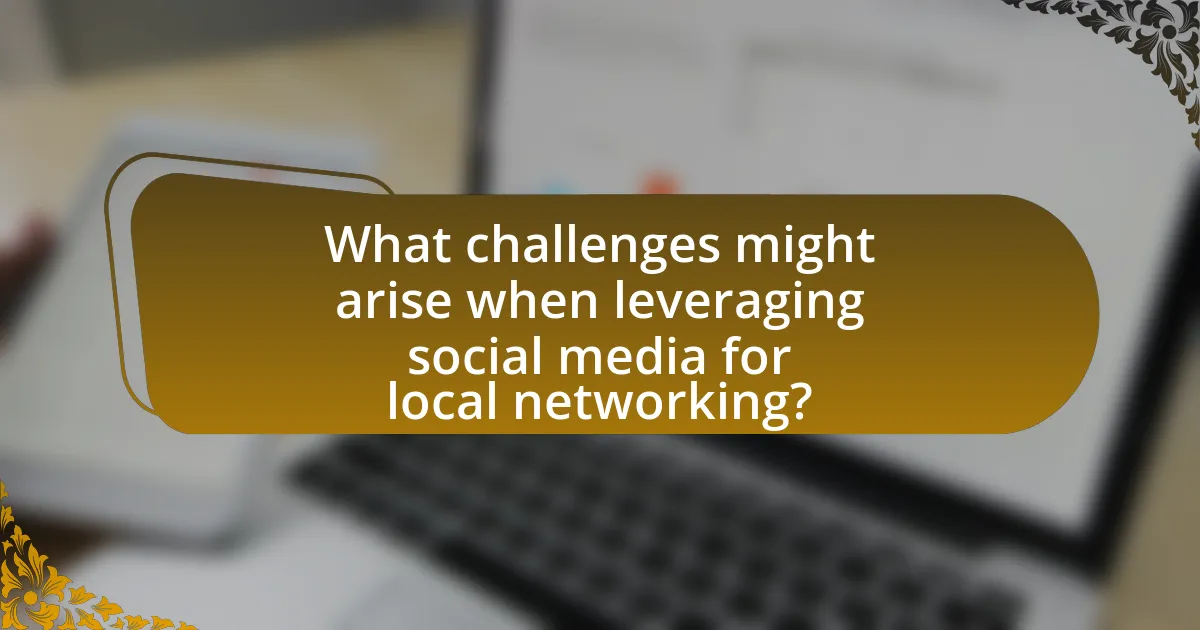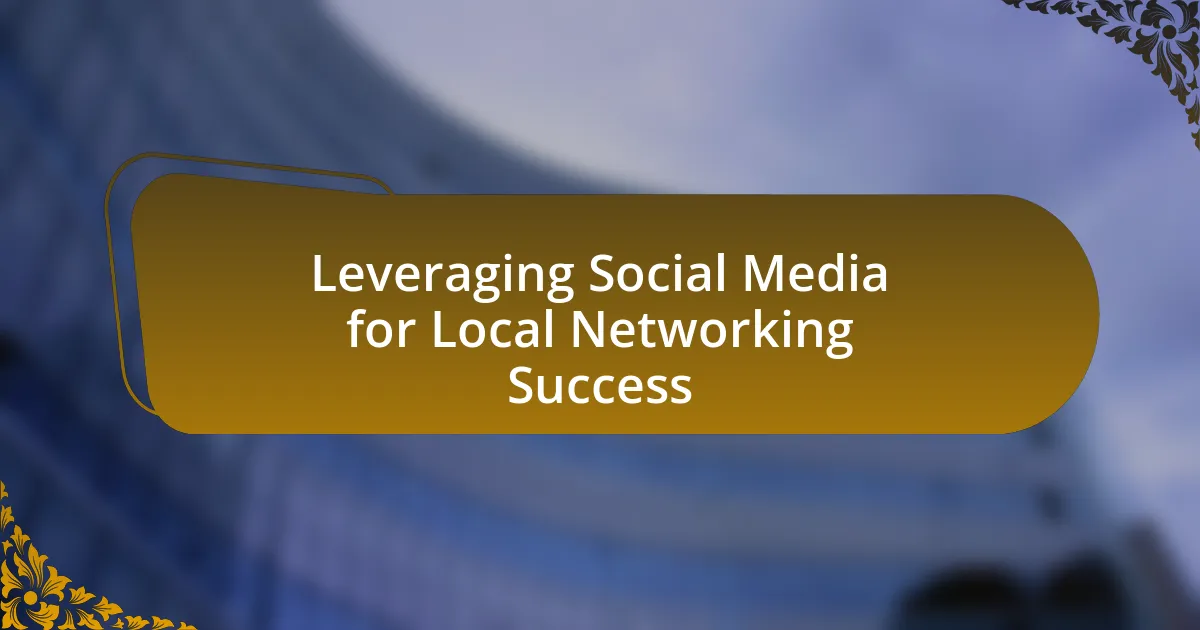Leveraging social media for local networking success involves using platforms such as Facebook, Instagram, and LinkedIn to build relationships and engage with community members and businesses. The article explores how social media enhances local networking opportunities through features like location tagging and local groups, while also highlighting the importance of community engagement for local businesses. It discusses strategies for effective networking, the significance of tailored content, and the challenges faced in establishing genuine connections online. Additionally, the article emphasizes the advantages of local networking over broader networking and provides practical tips for measuring success and maintaining authenticity in online interactions.

What does leveraging social media for local networking success entail?
Leveraging social media for local networking success entails utilizing platforms like Facebook, Instagram, and LinkedIn to build relationships and engage with community members and local businesses. This approach allows individuals and organizations to connect with a targeted audience, share relevant content, and participate in local discussions, thereby enhancing visibility and fostering trust within the community. Research indicates that 78% of small businesses report that social media is effective for attracting new customers, highlighting its importance in local networking efforts.
How can social media platforms enhance local networking opportunities?
Social media platforms enhance local networking opportunities by facilitating connections among individuals and businesses within a specific geographic area. These platforms allow users to join local groups, participate in community events, and share resources, which fosters collaboration and relationship-building. For instance, Facebook Groups and LinkedIn allow users to connect with local professionals, share job postings, and organize meetups, thereby increasing visibility and engagement within the community. According to a study by the Pew Research Center, 70% of adults in the U.S. use social media, indicating a significant potential for local networking through these channels.
What specific features of social media facilitate local connections?
Social media platforms facilitate local connections through features such as location tagging, local groups, event creation, and targeted advertising. Location tagging allows users to share their geographic location, making it easier for others in the vicinity to discover and connect with them. Local groups enable users to join communities based on shared interests or geographic areas, fostering interaction among nearby individuals. Event creation features allow users to organize and promote local gatherings, enhancing face-to-face networking opportunities. Targeted advertising helps businesses reach local audiences effectively, encouraging community engagement and support. These features collectively enhance the ability of individuals and organizations to connect within their local environments.
How do local businesses utilize social media for networking?
Local businesses utilize social media for networking by engaging with their community, building relationships, and promoting their services. They create profiles on platforms like Facebook, Instagram, and LinkedIn to connect with customers, share updates, and participate in local discussions. For instance, a study by the Pew Research Center indicates that 69% of adults in the U.S. use social media, providing a vast audience for local businesses to reach potential customers and partners. Additionally, local businesses often collaborate with other businesses through social media campaigns, fostering a sense of community and mutual support. This strategic use of social media not only enhances visibility but also strengthens local networks, ultimately driving customer loyalty and sales.
Why is local networking important in today’s digital landscape?
Local networking is crucial in today’s digital landscape because it fosters community engagement and builds trust among local businesses and consumers. In an era where online interactions often overshadow face-to-face connections, local networking allows businesses to establish meaningful relationships that can lead to increased customer loyalty and support. According to a study by the Local Search Association, 78% of consumers prefer to buy from local businesses, highlighting the importance of local connections in driving sales and brand recognition. Additionally, local networking enhances collaboration opportunities, enabling businesses to share resources and knowledge, which can lead to innovation and growth within the community.
What advantages does local networking provide over broader networking?
Local networking offers advantages such as stronger relationships and targeted opportunities compared to broader networking. Stronger relationships arise from frequent interactions within a community, fostering trust and collaboration among local contacts. Targeted opportunities are facilitated by a shared understanding of local market needs, enabling individuals to identify and leverage specific resources and connections that align with their goals. Research indicates that 70% of jobs are found through networking, emphasizing the effectiveness of local connections in job searches and business growth.
How does local networking impact community engagement?
Local networking significantly enhances community engagement by fostering relationships and facilitating communication among residents. When individuals connect through local networks, they share resources, information, and support, which strengthens community ties. Research indicates that communities with active local networks experience higher levels of participation in events and initiatives, as evidenced by a study from the Journal of Community Psychology, which found that neighborhoods with strong social networks reported a 30% increase in volunteerism and civic participation. This demonstrates that local networking not only builds trust but also encourages collaborative efforts, ultimately leading to a more engaged and cohesive community.

What strategies can be employed for effective local networking on social media?
Effective local networking on social media can be achieved through targeted engagement, community involvement, and strategic content sharing. Targeted engagement involves connecting with local businesses, influencers, and community groups by following them, commenting on their posts, and sharing relevant content. Community involvement can be enhanced by participating in local events, both online and offline, and promoting these events through social media channels. Strategic content sharing includes posting about local news, events, and initiatives that resonate with the community, which fosters a sense of belonging and encourages interaction. According to a study by the Pew Research Center, 69% of adults in the U.S. use social media, making it a vital platform for local networking.
How can individuals identify their target audience on social media?
Individuals can identify their target audience on social media by analyzing demographic data, engagement metrics, and user behavior. Social media platforms provide analytics tools that reveal insights such as age, gender, location, and interests of followers. For instance, Facebook Insights and Instagram Analytics allow users to track engagement rates and audience demographics, helping to refine content strategies. Research indicates that 70% of marketers find audience insights crucial for effective targeting, underscoring the importance of utilizing these analytics to tailor messaging and improve outreach.
What tools can assist in analyzing local demographics on social media?
Tools that can assist in analyzing local demographics on social media include Facebook Insights, Twitter Analytics, and Google Analytics. Facebook Insights provides detailed demographic data about users interacting with a page, including age, gender, and location, which helps businesses understand their audience better. Twitter Analytics offers insights into follower demographics and engagement metrics, allowing for targeted content strategies. Google Analytics can track social media traffic and user demographics on a website, providing a comprehensive view of how social media influences local audience behavior. These tools are widely used and recognized for their effectiveness in demographic analysis, making them essential for local networking success.
How can one tailor content to resonate with a local audience?
To tailor content to resonate with a local audience, one must incorporate local culture, language, and relevant community issues into the messaging. This approach ensures that the content feels relatable and authentic to the audience. For instance, using local dialects or references to regional events can enhance engagement. Research indicates that 70% of consumers prefer content that reflects their local culture, demonstrating the effectiveness of localized messaging in fostering connections.
What types of content are most effective for local networking?
Visual content, such as images and videos showcasing local events or community highlights, is most effective for local networking. This type of content engages audiences by providing relatable and shareable experiences, fostering a sense of community. According to a study by HubSpot, posts with images receive 94% more views than those without, emphasizing the importance of visual elements in capturing attention and encouraging interaction. Additionally, user-generated content, such as testimonials or local stories, enhances credibility and builds trust within the community, further solidifying local connections.
How can storytelling enhance local networking efforts on social media?
Storytelling enhances local networking efforts on social media by creating emotional connections and fostering community engagement. When individuals or businesses share relatable narratives, they capture attention and encourage interaction, which is essential for building relationships. Research indicates that posts with storytelling elements receive 300% more engagement than those without, highlighting the effectiveness of this approach. By weaving personal experiences or local anecdotes into their content, users can resonate with their audience, leading to increased trust and collaboration within the local network.
What role do visuals play in engaging a local audience?
Visuals play a crucial role in engaging a local audience by enhancing communication and increasing retention of information. Research indicates that people process visuals 60,000 times faster than text, making images, videos, and infographics effective tools for capturing attention and conveying messages quickly. Additionally, local audiences are more likely to connect with visuals that reflect their community, culture, and experiences, fostering a sense of belonging and relevance. For instance, a study by the Content Marketing Institute found that 70% of marketers believe that visual content is essential for engaging their target audience, particularly in localized marketing efforts. This demonstrates that incorporating relevant visuals can significantly improve engagement and interaction with local communities.

What challenges might arise when leveraging social media for local networking?
Leveraging social media for local networking can present several challenges, including information overload, privacy concerns, and the difficulty of establishing genuine connections. Information overload occurs when users are bombarded with excessive content, making it hard to identify relevant local opportunities. Privacy concerns arise as individuals may hesitate to share personal information online, fearing misuse or exposure. Additionally, establishing genuine connections can be challenging due to the impersonal nature of online interactions, which may lead to superficial relationships rather than meaningful networking. These challenges can hinder effective local networking efforts on social media platforms.
How can individuals overcome common obstacles in local networking?
Individuals can overcome common obstacles in local networking by actively utilizing social media platforms to connect with local professionals and organizations. Social media allows individuals to identify networking events, engage with community groups, and establish relationships with key influencers in their area. For instance, platforms like LinkedIn and Facebook provide features that enable users to join local networking groups, participate in discussions, and share relevant content, which can enhance visibility and credibility. Research indicates that 70% of professionals find networking through social media to be effective for building relationships, demonstrating its value in overcoming barriers such as geographical limitations and lack of in-person opportunities.
What strategies can mitigate the impact of negative feedback on social media?
To mitigate the impact of negative feedback on social media, organizations should implement proactive engagement strategies, including timely responses, transparent communication, and constructive dialogue. Timely responses to negative comments can demonstrate attentiveness and care, reducing the likelihood of escalation. Research indicates that 70% of consumers expect a response within 24 hours, highlighting the importance of promptness in addressing concerns. Transparent communication fosters trust, allowing organizations to clarify misunderstandings and provide context. Constructive dialogue encourages a two-way conversation, enabling organizations to understand the root of the feedback and address it effectively. By employing these strategies, organizations can not only minimize the adverse effects of negative feedback but also enhance their overall reputation and customer loyalty.
How can one maintain authenticity while networking online?
To maintain authenticity while networking online, individuals should focus on being transparent and true to their values. This involves sharing genuine experiences, insights, and opinions that reflect their true selves rather than adopting a persona that may not align with their real-life identity. Research indicates that authenticity fosters trust; a study published in the Journal of Business Research found that authentic self-presentation significantly enhances interpersonal trust in online interactions. By consistently engaging in honest communication and showcasing their unique perspectives, individuals can build meaningful connections that resonate with others in their network.
What best practices should be followed for successful local networking on social media?
Successful local networking on social media requires active engagement, targeted content, and community involvement. Engaging with local audiences through regular posts, comments, and direct messages fosters relationships and builds trust. Creating content that resonates with local interests, such as events, news, or community highlights, enhances relevance and encourages sharing. Participating in local groups or forums on platforms like Facebook or LinkedIn allows for direct interaction with community members, increasing visibility and connections. According to a study by the Pew Research Center, 70% of users engage with local businesses on social media, indicating the effectiveness of these practices in building local networks.
How often should one engage with their local audience on social media?
One should engage with their local audience on social media at least 3 to 5 times per week. This frequency allows for consistent interaction, which is essential for building relationships and maintaining visibility within the community. Research indicates that brands that post regularly see higher engagement rates; for instance, a study by HubSpot found that companies posting 16 or more times per month receive 3.5 times more traffic than those posting less frequently. Engaging regularly helps to foster a sense of community and encourages local followers to interact with the content, ultimately enhancing local networking success.
What are the key metrics to track for measuring local networking success?
The key metrics to track for measuring local networking success include the number of connections made, engagement rates, and referral conversions. Tracking the number of connections made helps quantify the growth of your local network, while engagement rates, such as likes, shares, and comments on social media posts, indicate the level of interaction and interest from your audience. Referral conversions measure how many of these connections lead to actual business opportunities or collaborations, providing a clear indicator of the effectiveness of your networking efforts. These metrics collectively offer a comprehensive view of local networking success, allowing for data-driven adjustments to strategies.
What practical tips can enhance local networking success through social media?
To enhance local networking success through social media, individuals should actively engage with local community groups and events online. By joining platforms like Facebook Groups or LinkedIn local chapters, users can connect with like-minded individuals and businesses in their area. Engaging in discussions, sharing relevant content, and attending virtual or in-person events promoted through these channels can significantly increase visibility and foster relationships. Research indicates that 70% of people find new opportunities through networking, highlighting the importance of active participation in local online communities.
